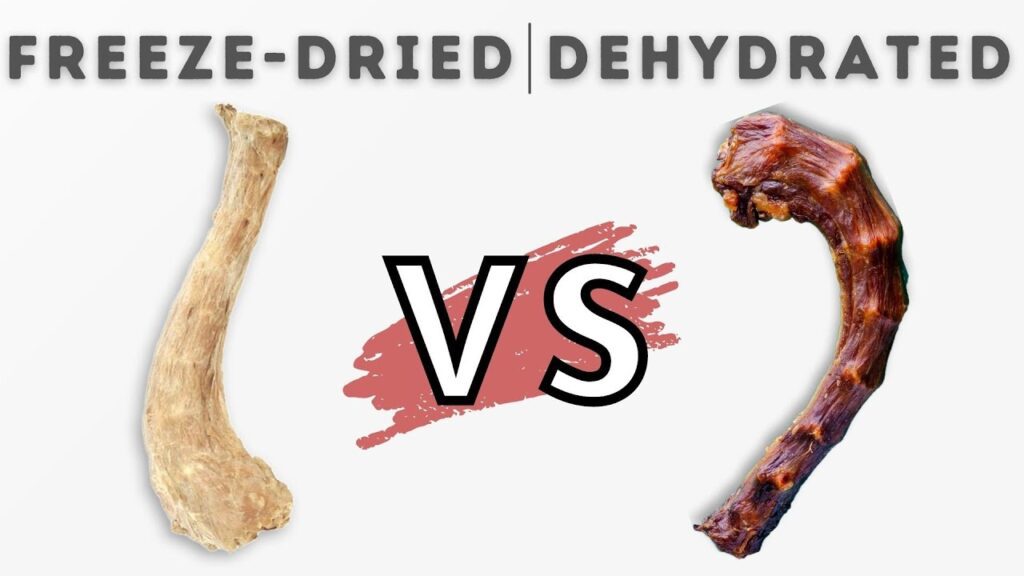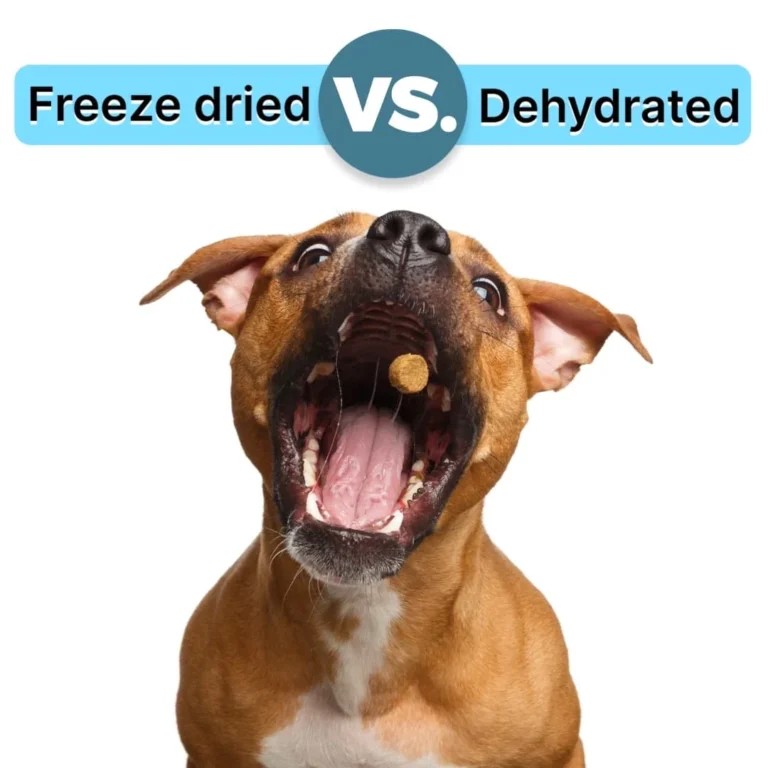When it comes to pampering our beloved pets, there is no limit to how far we will go. From lavish grooming sessions to gourmet food options, pet owners always look for new and innovative ways to show their furry friends how much they mean to them. One popular trend among dog owners is using freeze-dried and dehydrated treats as a healthy and convenient option for their four-legged companions. But what exactly are freeze-dried and dehydrated dog treats, and which is better? In this blog post, we will compare these two dog treats and help you decide the best choice for your canine companion.
What are Freeze-Dried Dog Treats?
Freeze-drying is a process that removes moisture from food through sublimation, turning water directly from ice to vapour. This technique preserves the integrity of the food’s cellular structure and nutrients, resulting in lightweight and shelf-stable freeze-dried dog treats. These treats maintain a similar texture and aroma to raw food, which can be more appealing and digestible for dogs. Freeze-dried dog treats also eliminate the need for refrigeration, making them an excellent choice for pet owners on the go. Not only are freeze-dried dog treats convenient, but their long shelf life ensures that the quality and taste remain intact, providing a delicious and nutritious snack for our canine friends.
What are Dehydrated Dog Treats?
Dehydration is a process that removes moisture from food by heating it at low temperatures and circulating warm, dry air around the ingredients. Unlike freeze-drying, dehydration does not involve sublimation and relies on evaporation to remove moisture. This method results in a denser and chewier texture, making dehydrated dog treats a longer-lasting snack for our furry companions. Dehydrated dog treats, also known as “jerky, ” are typically made from single-ingredient proteins, such as chicken or beef. These treats are often considered more natural and healthier than their freeze-dried counterparts, as they contain fewer additives and preservatives.
Freeze-Dried Dog Treats vs Dehydrated Dog Treats; Nutritional Comparison.
When it comes to nutrition, both freeze-dried and dehydrated dog treats offer some benefits. Freeze-dried treats retain most of their nutrients due to the sublimation process, making them a nutrient-dense option for our canine friends. However, since dehydration involves heating at low temperatures, some heat-sensitive vitamins and enzymes may be lost in the process. Nevertheless, dehydrated treats still offer a good source of protein and can be a suitable option for dogs with allergies or sensitivities to certain ingredients. Both dog treats can provide valuable nutrients to our furry companions when incorporated into a balanced diet.

Taste and Variety
When it comes to taste, both freeze-dried and dehydrated dog treats have their unique qualities. Freeze-dried treats tend to have a more potent aroma and taste, as they retain most of their natural flavours through the freeze-drying process. On the other hand, dehydrated treats can be more flavorful due to the slow cooking method, resulting in a rich and intense flavour that dogs love. As for variety, both dog treats come in a wide range of proteins, including chicken, beef, fish, and even exotic meats like venison or kangaroo. With so many options to choose from, you can easily find a treat that will satisfy your dog’s taste buds.
Cost Comparison
Regarding cost, freeze-dried dog treats tend to be more expensive than dehydrated dog treats due to the higher production costs involved in the freeze-drying process. Additionally, since freeze-dried treats have a longer shelf life, you may save money in the long run by not having to replace them as frequently. However, if you are on a tight budget, dehydrated dog treats can be a more affordable option without compromising quality and nutrition.
Which One is Better for Your Dog?
So, which one is better for your dog? The answer ultimately depends on your dog’s preferences and needs. If you have a picky eater or a dog with digestive sensitivities, freeze-dried treats may be the way to go due to their appealing texture and limited ingredients. On the other hand, if you have an active dog who enjoys chewing and needs a longer-lasting treat, dehydrated treats may be a better option. It’s always essential to consider your dog’s needs and consult with your veterinarian before introducing new treats into their diet.

Storage and Shelf Life
The decision between freeze-dried and dehydrated dog treats extends beyond just nutrition and cost–storage requirements and shelf life are also crucial factors for dog owners. Freeze-dried treats typically surpass dehydrated ones in terms of shelf life due to their low moisture content, significantly reducing the risk of microbial growth and spoilage. Such treats often remain fresh for months or even years when stored in a cool, dry place, making them a handy option for owners who prefer to stock up.
Conversely, dehydrated treats, while also benefitting from moisture removal, may have a slightly shorter shelf life due to residual moisture that can still be present after dehydration. It is imperative to store them properly, often in airtight containers, to inhibit any bacterial growth and maintain freshness.
Careful storage of dehydrated treats is especially crucial if they contain no added preservatives, which, while being a healthier choice, can leave them more susceptible to spoilage. Dog owners should always check expiration dates and abide by storage instructions to ensure their pets receive the freshest, safest treats possible.
Homemade vs Store-Bought Dog Treats
When choosing between homemade and store-bought dog treats, pet owners often weigh the benefits of freshness against convenience. Homemade dog treats allow complete control over the ingredients, enabling you to avoid preservatives, additives, and any allergens your dog might have. This control assures you that your pet is getting wholesome, high-quality nutrients, and you can tailor the treats to your pet’s specific dietary needs and preferences.
On the other hand, store-bought treats offer unparalleled convenience. They are readily available, come in various flavours and textures, and are often specifically formulated to provide complete and balanced nutrition that meets the standards set by pet food regulatory agencies. Furthermore, they can be more cost-effective, especially considering the time investment and ingredient purchase costs of making treats at home. However, store-bought options can sometimes contain less than-desirable ingredients for your pet’s health, making it essential to read labels carefully.

Thus, whether you choose to make dog treats at home or purchase them from the store largely depends on your lifestyle, time resources, and the level of dietary customization your dog may require. Both options can fit into a healthy diet for your dog, provided they are used in moderation as a treat and not a substitute for a balanced diet.
Conclusion
In conclusion, freeze-dried and dehydrated dog treats can be a healthy and convenient option for our four-legged companions. While freeze-dried treats retain most nutrients and have a longer shelf life, dehydrated treats offer a more natural and flavorful option without breaking the bank. Ultimately, choosing a treat that your dog enjoys and fits into their overall diet plan is essential.
Whichever type of treat you decide to incorporate, always read the ingredients list and choose high-quality options for your beloved furry friend. After all, nothing beats seeing the joy on our dog’s faces when they are happily munching on their favourite treats. So, spoil your furry friend with a delicious and nutritious treat today! Happy snacking! Keep exploring new ways to show love and care for your pet. You might discover a new trend or product that will bring even more.

Frequently Asked Questions (FAQs)
Q: How often should I give my dog treats?
A: Treats should be given in moderation and should not exceed 10% of your dog’s daily caloric intake. It is essential to factor in treats when calculating your dog’s daily calorie consumption.
Q: Can dogs with food allergies have freeze-dried or dehydrated treats?
A: Many freeze-dried and dehydrated treats are made with single protein sources, which can be suitable for dogs with food allergies. Always check the ingredients list to ensure the treat doesn’t contain your dog’s specific allergens.
Q: Are there any preservatives in freeze-dried or dehydrated dog treats?
A: Generally, both types of treats aim to minimize the use of preservatives due to the preservation process itself. However, always read the packaging to confirm that no additional preservatives have been added, especially if you want a natural option.
Q: Can freeze-dried and dehydrated treats replace a meal for my dog?
A: No, these treats are intended to supplement your dog’s diet and should not replace complete and balanced meals. They should be used as a reward or occasional snack.
Q: How long can I store opened bags of freeze-dried or dehydrated treats?
A: Check the packaging for the manufacturer’s recommended storage instructions. Generally, these treats should be consumed within a few weeks to maintain freshness and kept in an airtight container after opening.
Q: Are homemade dog treats healthier than store-bought ones?
A: Homemade treats can be healthier by using high-quality, fresh ingredients and avoiding adding preservatives or additives. However, it’s essential to ensure that homemade treats are nutritionally balanced and that you know about the safe ingredients for dogs.
More Posts To Read;



2 Comments
Pingback: Is Victor dog food good for German Shepherds: the best option available.
Pingback: Elite Nutrition Dog Food for Large Dogs: Discover 5 hidden secrets in the food.